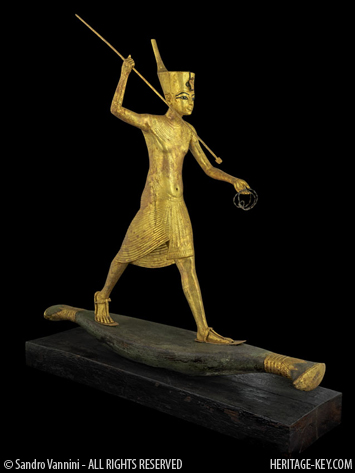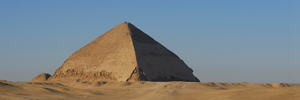 A large new church, monastic burials and a vaulted room filled with Coptic wall paintings – new excavation work at the Monastery of Saint Apollo at Bawit is yielding a wealth of remarkable finds. One of the team members, Dr. Ramez Boutros of the University of Toronto, discussed some of the finds at a recent lecture and Heritage Key followed up with an interview.
A large new church, monastic burials and a vaulted room filled with Coptic wall paintings – new excavation work at the Monastery of Saint Apollo at Bawit is yielding a wealth of remarkable finds. One of the team members, Dr. Ramez Boutros of the University of Toronto, discussed some of the finds at a recent lecture and Heritage Key followed up with an interview.
The Monastery of Saint Apollo was founded by the saint around 385-390 AD. Its slightly north to the site of Asyut, which can be seen on the map below.
Saint Apollo was a hermit of sorts who lived out in the desert. Dr. Boutros told me that fourth century Palestinian monks record that they met with him and that he was already surrounded by a few disciples. Two companions were particularly close to him – Phib and Anoup.
He was so spiritual that he was called the friend of the angels speaking and dialoguing with angels, said Dr. Boutros.
The Vitae Patrum, a compilation of early Christian writings published in 1628, records one piece by an unknown author:
In the deserts there we saw a man called Apollo who had a monastery in the mountains. He was the father of about five hundred monks, and was very well known and admired throughout the Thebaid. He did great things, the Lord endowed him with many powers and many signs and wonders were done through him. From boyhood he had used a strict discipline and he grew in grace with age. When he was eighty he had gathered a great monastery of flawless men, who were all capable of performing signs. – From a translation by Rev. Benedict Baker.
The North and South Churches of Bawit
 The monastery flourished until the 8th/9th century AD and then declined. Boutros said that the new excavations show no sign of vandalism or destruction of the monastery. Instead it appears to have become abandoned over time.
The monastery flourished until the 8th/9th century AD and then declined. Boutros said that the new excavations show no sign of vandalism or destruction of the monastery. Instead it appears to have become abandoned over time.
Between 1901 and 1913 the monastery was excavated by archaeologists from the French Institute in Cairo. They unearthed two churches called the ‘south church’ and the ‘north church’.
The Louvre has a 3D reconstruction of the south church. It was in use during the 7th century AD and was 15 meters by 11.5 meters in size. The church was made up of a sanctuary and nave. It was separated from the other areas by corridors decorated with wood and limestone sculptures. You can also see many of the treasures that were discovered in the early 20th century in the Bawit Room at The Louvre.
The north church is longer and also appears to have been divided in two. A wooden screen ran through the middle of the church. Although partially excavated in the early 20th century, theexcavation notes were never fully published and The Louvre is now trying to finish unearthing the structure. It appears that this church is a bit younger then the south church, perhaps dating to the 8th century AD.
Professor Anne Marie Luijendijk, of Princeton University, wrote in a recent article in the Bryn Mawr Classical Review that:
The monastic complex (as a whole) featured at least two churches, dining halls, monastic cells including special cells for children, a bakery, oil and wine presses, and almost 100 acres of landholdings. Library, scriptorium, or school have not been identified, although they would have formed part of a big monastery.
A New Church with Burials
The biggest news is that archaeologists have discovered a third church at Bawit. It was found using geomagnetic equipment and archaeologists are now digging into it. It is located to the south of the two previously-discovered churches. Few architectural details are available but archaeologists know that itis a big structure, more than double the size of the south church shown in the 3D reconstruction.
 Dr. Boutros said that the church has an early date, meaning before the Islamic conquest of Egypt in AD 641. He says that he cannot be more specific than that at this time.
Dr. Boutros said that the church has an early date, meaning before the Islamic conquest of Egypt in AD 641. He says that he cannot be more specific than that at this time.
Underneath the floor of the church the archaeological team found burials. So far the team has found less than a dozen of them. They were monks from the time of the monastery, probably, said Boutros.
When the burials were discovered the team had to stop digging because they did not have a physical anthropologist on hand who could properly analyze the bodies.
A tantalizing possibility, which I asked about, is whether any of these burials could be that of Phib, Anoup or even Saint Apollo himself. Boutros said that the team would not be able to prove this unless an inscription, giving the names of the people buried, is found.
There are of course stories about Saints whose remainsdont decompose in a normal way and stay preserved over long periods of time. Until physical anthropological work is done the excavators are not going to know if any of the bodies exhibit anything like that.
A Hermitage and a Vaulted Room
Excavations in the area near the north church have unearthed a hermitage. It dates to the first quarter of the 7th century AD. Dr. Boutros said that its big enough for an elder and two or three monks. They discovered lots of pottery and a wooden codex holder, something that a book could be put on. They found the codex holder in the kitchen of all places.
In the northern area the archaeologists also found a collapsed Nubian vault. Its a type of architectural style that uses reclining arches to create a vaulted structure. This particular vault was built with mud brick and was covered with wall paintings. It collapsed in ancient times, possibly because of its design.
The vault is five meters by 25 meters in size. Its a huge one, Dr. Boutros said, explaingin that the vault had a very wide span for a Nubian vault, he said. This is a design decision which would have led to a lot of stresses.
The Art
 When I asked Dr. Boutros where the team discovered art, he responded with one word everywhere.
When I asked Dr. Boutros where the team discovered art, he responded with one word everywhere.
It must have been really very beautiful, he added.
Not only because of this world of monastic visions and colors, because of the architecture. The vaults and domes were all plastered in white.
The archaeologists cannot release pictures of the new finds until they are published in a scholarly format.
Dr. Boutros explained that on one wall there would be a depiction of the Life of Mary, the theme of Joseph, the trip to Bethlehem, the nativity, the shepherds and the kings, the Wisemen, the Virgin Mary sitting on the throne”.
The other wall will have bench, Apollo sitting with Anoup and Phib – they were often represented on wall paintings in the rooms.
Opposite to the wall of the life of Mary – you will have the prophets of the Old Testament all carrying scrolls, with the text related to the prophecies about Mary from the Bible.
There were also depictions of local saints. Some of the scenes were painted by monks, but others may have been created by professional artists.
Its a testament to Saint Apollos life that depictions of him, along with Anoup and Phib, were drawn throughout the life of monastery. They were often represented on the wall paintings in the rooms, said Dr. Boutros. They were venerated, they were really the Saints, the founders of the site.
To find out more about ancient Christian monasteries in Egypt, watch our Heritage Key video below, which gives a unique insight into the restoration of Saint Anthony’s Monastery, and the history of Coptic Christianity in Egypt.
Video: The Restoration of Saint Anthony’s Monastery near Al-Zaafarana, Egypt
Check out more great archaevideos here on Heritage Key. Highlights include Dr Zahi Hawass discussing the restoration of the Synagogue of Moses Ben Maimon in Cairo, a look at the search for the lost tombs of Thebes, featuring Zahi Hawass, Dr Mark Lehner talking about the lives of pyramid builders in ancient Egypt and Dr Alain Zivie on the restoration of the tomb of Aper-el.



